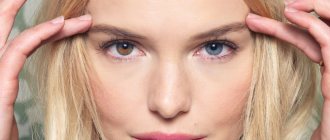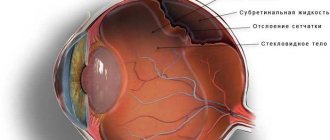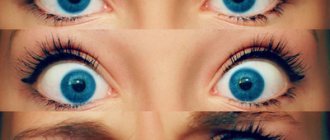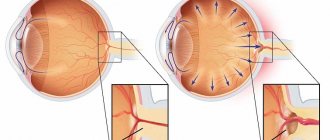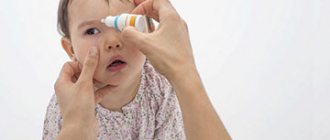Causes of visual impairment [1]
Tired eye syndrome (asthenopia) is a diagnosis that appeared long before the advent of computers and was associated with long-term daily reading. Now that you mostly have to read not from paper, but from electronic media, eye strain increases due to backlighting, flickering of monitors, incorrect color rendition, changes in brightness, and glare. Asthenopia manifests itself in the form of several symptoms:
- Weakening of the eye muscles. The visual apparatus is initially designed in such a way as to focus mostly on distant objects and track what is happening around. A modern person spends hours looking at a computer, TV or smartphone screen, so the eye muscles do not receive the proper load.
- Eye fatigue. It is impossible to endlessly look at illuminated texts and pictures: eventually the eyes stop focusing and the image begins to blur.
- Stinging and burning in the eyes . The frequency of blinking when working at the monitor is reduced, so the eyeball is not sufficiently wetted, which leads to pain. The eyes may begin to water and become red.
In addition to asthenopia, one should be aware of the harmful effects of light on the retina (photodamage), which accumulates over the years and leads to serious ophthalmological diseases.
Recommendations for choosing drops for dry eyes
In the past, the choice of drops for dry eyes was limited to lubricants. Typically, these were drops based on a cellulose derivative containing benzalkonium chloride as a preservative, or an ointment based on lanolin; both remedies had a softening effect, providing only short-term relief. There have been significant advances in drug formulation over the past 20 years, primarily through more modern products classified as “medical devices” or “cosmetics.” However, it would be a mistake to assume that dosage forms have become less complex or effective than products that have been on the market for a long time; in many cases the opposite is true. The best products should do their best to: influence both the tonicity and stability of the tear film and protect the ocular surface from drying out between blinks. Here are five simple guidelines for choosing the most effective drops for dry eyes: 1. Avoid preservatives whenever possible. At low dosages, the absence of preservatives, especially benzalkonium chloride, is more important than the active ingredient. The negative effects of this type of preservative on the ocular surface are widely known. Even other preservatives that disintegrate after instillation do not always completely dissipate in a dry eye with low tear volume. If the patient is also taking other preservative-containing topical medications to treat glaucoma, it is even more important to use preservative-free medications for dry eye. 2. Choose a solution with a sufficiently low osmotic pressure. This will help eliminate the increased tear osmolarity in dry eyes, which is the main driver of inflammation. This is especially true for patients complaining of burning and stinging sensations. 3. Choose products that contain ingredients that mimic the viscoelastic properties of the tear film. This is hyaluronic acid or its sodium salt. Having a structure of polysaccharide chains that replicates the structure of a sponge, retains water and slows down evaporation when released into an aqueous solution, hyaluronic acid is an excellent natural lubricant in the human body. Hydrated hyaluronic acid can contain up to 1000 times its own weight in water, providing enhanced hydration to the ocular surface. Many clinical studies demonstrate superiority over traditional cellulose derivatives, PVA, etc. An alternative derived from tropical wood is hydroxypropyl guar (HPG), an ingredient that acts like a gelling agent when in contact with tears. It has properties similar to those of the tear film. Both of these smart ingredients also exhibit mucoadhesive properties, coating the ocular surface by interacting with the mucin layer. In addition to HA or GPG, the formulation may also contain more traditional ingredients such as cellulose derivatives, PEGs, PVA, which act as adjuvants to improve retention time. 4. Choose ingredients that protect the ocular surface. Molecules of substances such as trehalose protect corneal epithelial cells from death as a result of drying out and provide resistance to high osmolarity, protecting proteins and membranes from denaturation. Trehalose is known to protect corneal cells before LASEK surgery. Other osmoprotectors are L-carnitine and erythritol, alone or in combination. 5. Finally, you need to consider how you will use the product. Choose bottles that are easy to squeeze or drops in single-dose packaging - different drops require different pressure to be instilled. There is a huge selection of moisturizing eye drops, but it is possible to compare the etiology with the science behind the composition of these modern products. In more complex cases, we can recommend an integrated approach that includes eyelid care, the use of artificial tears and proper nutrition.
So, consuming omega-3 improves the secretion of the meibomian glands and the stability of the tear film, reduces inflammation and apoptosis, enhances secretion, and taking omega-6 (GLA) increases tear production. The risk of taking omega-3 supplements remains unproven: theoretically, excess omega-3 EFAs may cause bleeding due to their anticoagulant properties, so individuals with bleeding disorders should consult a physician first.
How to protect your eyes from the computer [2, 3]
Since asthenopia has vivid symptoms and sharply reduces performance, a number of means already exist to combat it:
- Proper organization of the workplace. The distance from the eyes to the computer monitor should be at least 60-70 cm.
- Barrier methods. Anti-glare films and screen coatings reduce eye strain.
- Using eye drops. Dry eyes from a computer can be reduced by using special medications (after consultation with an ophthalmologist).
- Alternation of work and rest. A subjective feeling of eye fatigue appears after 3 hours of working at the monitor. But in fact, the eyes begin to get tired much earlier: after one or two. Therefore, it is necessary to break away from the monitor for 10-15 minutes and look at distant objects approximately once an hour.
- Gymnastics for the eyes. When working at a computer, it is useful to perform a set of simple exercises at least once a day: roll your eyes, look at some object in the distance, close your eyes and lightly press your fingers on the upper eyelids.
Photodamage is not as obvious as computer eye fatigue, but it is easier to prevent than to treat. To do this, you should pay attention to your diet.
What Causes Dry Eye Syndrome
Gadget screens
We mean any screen - computer, tablet or phone. Staring at any screen for too long can cause your eyes to dry out. The fact is that bright light makes us concentrate and look more closely. We are too involved, and our eyes simply “forget” to blink. The fact is that blinking is an unconditioned reflex; we don’t think about it. And this reflex slows down when our attention is excessively focused on something.
Dry air
We have dry air everywhere. In the office and at home, batteries work in winter, and air conditioning in summer. And on the street: just remember what it’s like to walk in the heat - your throat gets dry, not to mention your eyes.
Dry air dries up the tears that should wash the eye. And it is even more dangerous than a computer screen.
Few people know that our cornea (this is the transparent outer shell of the eye) does not have blood vessels, that is, it is nourished by tears. For example, a tear must deliver oxygen to it. How will she do this if she dries out under the influence of dry air? The less oxygen and nutrients the cornea receives, the worse its condition.
Hormones
This reason is purely female. During menopause, which can begin at a fairly early age, the amount of estrogen in a woman’s body decreases. These hormones affect fat metabolism. They also reduce the amount of fatty components of tears. This means that the consistency of the tear changes, it becomes more liquid and cannot stay on the eye. In such cases, women may experience causeless lacrimation.
Contact lenses
Even if you remember to take your lenses out at night, if you change them every day and make sure your containers are sterile, you still can't avoid dry eyes.
Wearing lenses for a long time = dry eye syndrome. This is an axiom. Lenses disrupt the tear layers, deteriorate their quality and dry out the eye.
Ideally, you should not wear lenses every day, but only when necessary. Of course, for a person with poor eyesight this is simply impossible. Replace lenses with glasses? Again, this is inconvenient for many.
Therefore, if you have poor vision, there are two options:
- Ask your doctor to prescribe artificial tears and drop them into your eyes constantly.
- Get laser vision correction if you have no contraindications, and forget about lenses. However, preparation for the operation must be carried out correctly - see the next point.
Laser vision correction
Dry eye syndrome often worsens after laser vision correction. But this happens if the preparation for correction was carried out incorrectly. Before surgery, the above-mentioned Schirmer test, a dry eye test, should be done. And if necessary, treat this syndrome, but not with drops, but with more effective laser stimulation. If this technology is followed, then laser correction will take place without problems.
Medicines
Some medications cause dry eyes. These are usually antidepressants and oral contraceptives. The drugs affect hormonal levels, which, in turn, affect the fatty component of tears. The tear film loses its stability and the eye dries out. In parallel with taking these medications, it is better to use artificial tears.
Chronic diseases: diabetes, conjunctivitis, blepharitis
Diabetes mellitus , in addition to many other unpleasant consequences, also causes dry eyes. But with proper compensatory therapy, such a problem does not arise.
When treating conjunctivitis, antibiotics are used that interfere with the quality of tears. Therefore, after treating this disease, it is imperative to be treated for dry eye syndrome.
Blepharitis is a chronic inflammation of the eyelids, which also affects the quality of tears. Until it is treated, dry eyes will not go away.
Treatment of eye pathologies in diabetes mellitus
If eye disease is detected in the early stages of its manifestations, it is possible to significantly slow down the deterioration of the condition through compensatory therapy for diabetes mellitus.
For direct treatment of eye pathology, drops applied conjunctivally are usually prescribed. Surgical intervention may be required only in severe cases of the disease and in advanced forms of eye disease.
The risk group for developing ophthalmological pathologies includes all patients with diabetes mellitus. To slow down the course of the disease, annual complete ophthalmological examinations, dietary adjustments, and constant monitoring of blood glucose levels are required.
Eye drops for diabetes mellitus are prescribed by an ophthalmologist, both to treat identified pathologies of the visual system and to prevent its occurrence.
